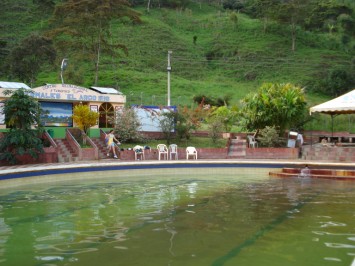|
Salzderhelden Saltworks
Salzderhelden saltworks (german: Saline Salzderhelden) was a saline in Salzderhelden, a district of Einbeck city, Germany. History The start of salt extraction at the site began in 1757. A brine spring had been discovered in the proximity much earlier, in the medieval ages. That was feasible because a Zechstein layer is located in the ground. A graduation tower was built in 1772. From 1851 on balneotherapy was offered for guests. In 1860 a drilling for brine was set as deep as 450m into the ground, replacing the graduation tower.Hans-Heinz Emons, Hans-Henning Walter: Alte Salinen in Mitteleuropa, 1988, p. 141 Also, a steam engine was installed to lift the brine to the surface. The steam engine replaced wind mills that had been in use until then. A second derrick was built in 1884. An electrical pump replaced the steam engine in 1920. Power transmission was achieved by line shaft. In the 20th century the facility was shut down, but the drilling tower was preserved and is an ind ... [...More Info...] [...Related Items...] OR: [Wikipedia] [Google] [Baidu] |
Saltern
A saltern is an area or installation for making salt. Salterns include modern salt-making works (saltworks), as well as hypersaline waters that usually contain high concentrations of halophilic microorganisms, primarily haloarchaea but also other halophiles including algae and bacteria. Salterns usually begin with seawater as the initial source of brine but may also use natural saltwater springs and streams. The water is evaporated, usually over a series of ponds, to the point where sodium chloride and other salts precipitate out of the saturated brine, allowing pure salts to be harvested. Where complete evaporation in this fashion was not routinely achievable due to weather, salt was produced from the concentrated brine by boiling the brine. Background Earliest examples of pans used in the solution mining of salt date back to prehistoric times and the pans were made of ceramics known as briquetage. Later examples were made from lead and then iron. The change from lead to iron c ... [...More Info...] [...Related Items...] OR: [Wikipedia] [Google] [Baidu] |
Einbeck
Einbeck (; Eastphalian: ''Aimbeck'') is a town in the district Northeim, in southern Lower Saxony, Germany, on the German Timber-Frame Road. History Prehistory The area of the current city of Einbeck is inhabited since prehistoric times. Various artifacts have been unearthed in the city of Einbeck itself and in the little villages and lost villages around it over the years. They date back to the Paleolithic Era. Medieval period In the Early Middle Ages a number of villages existed along the river Ilme in the middle Leine valley before Einbeck was founded. On January 1, 1158 Einbeck was first mentioned in a deed of Friedrich Barbarossa, which mentioned ''… in loco qui Einbike vocatur …''. and related to a transfer of an estate in the 11th century. Count Udo of Katlenburg owned an estate on the bank of a brook, the Krummes Wasser (crooked water). His grandson founded the stift Sankt Alexandri, that subsequently developed into an important sanctuary. On the other side of ... [...More Info...] [...Related Items...] OR: [Wikipedia] [Google] [Baidu] |
Brine Spring
A brine spring or salt spring is a saltwater spring. Brine springs are not necessarily associated with halite deposits in the immediate vicinity. They may occur at valley bottoms made of clay and gravel which became soggy with brine seeped downslope from the valley sides. Historically, brine springs have been early sources of U.S. salt production, as in the case of the salterns in Syracuse, New York and at the Illinois Salines. See also *Saline seep *Salt lick *Mineral spring Mineral springs are naturally occurring springs that produces hard water, water that contains dissolved minerals. Salts, sulfur compounds, and gases are among the substances that can be dissolved in the spring water during its passage under ... References Salts Springs (hydrology) * {{hydrology-stub ... [...More Info...] [...Related Items...] OR: [Wikipedia] [Google] [Baidu] |
Zechstein
The Zechstein (German either from ''mine stone'' or ''tough stone'') is a unit of sedimentary rock layers of Middle to Late Permian (Guadalupian to Lopingian) age located in the European Permian Basin which stretches from the east coast of England to northern Poland. The name Zechstein was formerly also used as a unit of time in the geologic timescale, but nowadays it is only used for the corresponding sedimentary deposits in Europe. The Zechstein lies on top of the Rotliegend; on top of the Zechstein is the Buntsandstein or Bunter. Formation The evaporite rocks of the Zechstein formation were laid down by the Zechstein Sea, an epicontinental or epeiric sea that existed in the Guadalupian and Lopingian epochs of the Permian period. The Zechstein Sea occupied the region of what is now the North Sea, plus lowland areas of Britain and the north European plain through Germany and Poland. The Zechstein sea lay in the rain shadow of the Central Pangean Mountains to the south. At times ... [...More Info...] [...Related Items...] OR: [Wikipedia] [Google] [Baidu] |
Alexander Von Humboldt
Friedrich Wilhelm Heinrich Alexander von Humboldt (14 September 17696 May 1859) was a German polymath, geographer, naturalist, explorer, and proponent of Romantic philosophy and science. He was the younger brother of the Prussian minister, philosopher, and linguist Wilhelm von Humboldt (1767–1835). Humboldt's quantitative work on botanical geography laid the foundation for the field of biogeography. Humboldt's advocacy of long-term systematic geophysical measurement laid the foundation for modern geomagnetic and meteorological monitoring. Between 1799 and 1804, Humboldt travelled extensively in the Americas, exploring and describing them for the first time from a modern Western scientific point of view. His description of the journey was written up and published in several volumes over 21 years. Humboldt was one of the first people to propose that the lands bordering the Atlantic Ocean were once joined (South America and Africa in particular). Humboldt resurrected th ... [...More Info...] [...Related Items...] OR: [Wikipedia] [Google] [Baidu] |
Graduation Tower
A graduation tower (occasionally referred to as a thorn house) is a structure used in the production of salt which removes water from a saline solution by evaporation, increasing its concentration of mineral salts. The tower consists of a wooden wall-like frame stuffed with bundles of brushwood (typically blackthorn) which have to be changed about every 5 to 10 years as they become encrusted with mineral deposits over time. The salt water runs down the tower and partly evaporates; at the same time some minerals from the solution are left behind on the brushwood twigs. Graduation towers can be found in a number of spa towns, primarily in Germany but also Poland and Austria. The mineral-rich water droplets in the air are regarded as having beneficial health effects similar to that of breathing in sea air. A large complex of graduation towers is located in Ciechocinek and Inowrocław, Poland.Affelt, Waldemar: Wooden masterwork of saline in Ciechocinek, Poland'', in: Santiago Hue ... [...More Info...] [...Related Items...] OR: [Wikipedia] [Google] [Baidu] |
Balneotherapy
Balneotherapy ( la, balneum "bath") is a method of treating diseases by bathing, a traditional medicine technique usually practiced at spas. Since ancient times, humans have used hot springs, public baths and thermal medicine for therapeutic effects. While it is considered distinct from hydrotherapy, there are some overlaps in practice and in underlying principles. Balneotherapy may involve hot or cold water, massage through moving water, relaxation, or stimulation. Many mineral waters at spas are rich in particular minerals such as silica, sulfur, selenium, and radium. Medicinal clays are also widely used, a practice known as 'fangotherapy'. Definition and characteristics "Balneotherapy" is the practice of immersing a subject in mineral water or mineral-laden mud; it is part of the traditional medicine of many cultures and originated in hot springs, cold water springs, or other sources of such water, like the Dead Sea. Presumed effect on diseases Balneotherapy may ... [...More Info...] [...Related Items...] OR: [Wikipedia] [Google] [Baidu] |
Brine
Brine is a high-concentration solution of salt (NaCl) in water (H2O). In diverse contexts, ''brine'' may refer to the salt solutions ranging from about 3.5% (a typical concentration of seawater, on the lower end of that of solutions used for brining foods) up to about 26% (a typical saturated solution, depending on temperature). Brine forms naturally due to evaporation of ground saline water but it is also generated in the mining of sodium chloride. Brine is used for food processing and cooking ( pickling and brining), for de-icing of roads and other structures, and in a number of technological processes. It is also a by-product of many industrial processes, such as desalination, so it requires wastewater treatment for proper disposal or further utilization ( fresh water recovery). In nature Brines are produced in multiple ways in nature. Modification of seawater via evaporation results in the concentration of salts in the residual fluid, a characteristic geologic depos ... [...More Info...] [...Related Items...] OR: [Wikipedia] [Google] [Baidu] |
Derrick
A derrick is a lifting device composed at minimum of one guyed mast, as in a gin pole, which may be articulated over a load by adjusting its guys. Most derricks have at least two components, either a guyed mast or self-supporting tower, and a boom hinged at its base to provide articulation, as in a ''stiffleg'' derrick. The most basic type of derrick is controlled by three or four lines connected to the top of the mast, which allow it both to move laterally and cant up and down. To lift a load, a separate line runs up and over the mast with a hook on its free end, as with a crane. Forms of derricks are commonly found aboard ships and at docking facilities. Some large derricks are mounted on dedicated vessels, and known as floating derricks and sheerlegs. The term derrick is also applied to the framework supporting a drilling apparatus in an oil rig. The derrick derives its name from a type of gallows named after Thomas Derrick, an Elizabethan era English executioner. ... [...More Info...] [...Related Items...] OR: [Wikipedia] [Google] [Baidu] |
Line Shaft
A line shaft is a power-driven rotating shaft for power transmission that was used extensively from the Industrial Revolution until the early 20th century. Prior to the widespread use of electric motors small enough to be connected directly to each piece of machinery, line shafting was used to distribute power from a large central power source to machinery throughout a workshop or an industrial complex. The central power source could be a water wheel, turbine, windmill, animal power or a steam engine. Power was distributed from the shaft to the machinery by a system of belts, pulleys and gears known as ''millwork''. Operation A typical line shaft would be suspended from the ceiling of one area and would run the length of that area. One pulley on the shaft would receive the power from a parent line shaft elsewhere in the building. The other pulleys would supply power to pulleys on each individual machine or to subsequent line shafts. In manufacturing where there were a ... [...More Info...] [...Related Items...] OR: [Wikipedia] [Google] [Baidu] |







